Gành Đá Đĩa, or the Sea Cliff of Stone Plates, is a majestic natural wonder nestled in An Ninh Dong Commune within Tuy An District, Phu Yen Province, Vietnam. This geological formation captivates visitors with its unique interlocking basalt columns, quite unlike anything else found in the region. These remarkable structures not only create a striking visual aftereffects against the backdrop of the horizon but also tell a story of the geological forces that shaped this landscape millions of years ago. The formation, stretching over an estimated 100 meters in width and 250 meters in length, is home to around 35,000 basalt columns, creating a breathtaking site with aesthetics that can only be compared to the likes of Ireland's Giant's Causeway. Formed approximately 200 million years ago, Gành Đá Đĩa not only serves as a geological treasure trove but also as an important cultural heritage site, officially recognized as a National Heritage site by Vietnam's Ministry of Culture, Sports and Tourism. This status not only protects it for future generations but also highlights its importance as a prime destination for tourists seeking to appreciate the incredible beauty of nature.
The geological formation of Gành Đá Đĩa is a testament to nature's awe-inspiring processes. This natural wonder has captured the attention of scientists and tourists alike due to its unique features and the curious manner in which it came into existence. The site is a series of basalt columns, primarily shaped as hexagons, pentagons, and other polygons, formed through a physical process resulting from ancient volcanic activity that occurred around 200 million years ago. The cooling lava flowed into the sea, resulting in a rapid shift in temperature that cooled the molten rock almost instantaneously. This drastic temperature change caused the lava to contract and fracture into distinct shapes.
The columns at Gành Đá Đĩa offer a fascinating microscopic glimpse into the geological history of Vietnam. The surface of the basalt columns showcases a variety of textures and formations, creating a visually stunning landscape that can be likened to a giant beehive. Viewed from a distance, the formations resemble a colossal set of stone plates stacked upon one another, an inspiration for the name "Gành Đá Đĩa" which translates to "stone plate reef." These columns not only reflect the geological activity of the past but also highlight the dynamic forces of nature that continue to shape the Earth's surface.
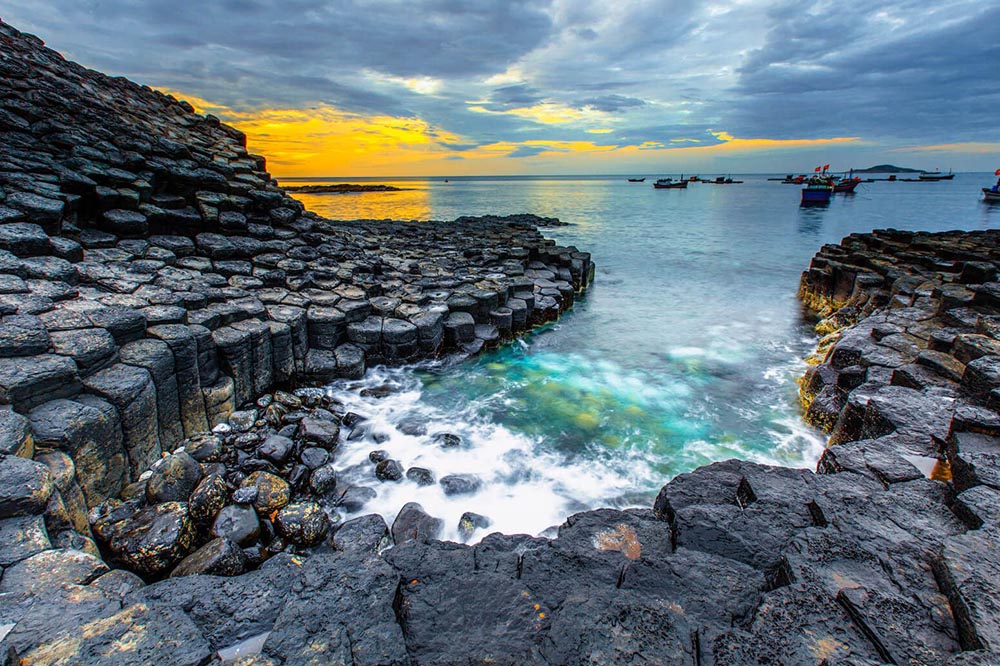
The formation of the basalt columns at Gành Đá Đĩa results from a series of geological events that unfolded through millions of years of volcanic activity. When lava erupts from a volcano, it is extremely hot and flows outwards in molten streams. As this hot lava meets the comparatively cool waters of the ocean, it experiences a dramatic temperature drop. This sudden cooling is pivotal in shaping the distinct characteristics of the basalt columns.
Thermal Contraction: The rapid cooling causes the molten rock to contract, leading to internal stress. This stress results in the fracturing of the rock as it attempts to stabilize. The shapes of the fractures often align in geometric patterns, creating the hexagonal formations that are notably seen at Gành Đá Đĩa.
Natural Fracturing Process: The natural structure of basalt allows it to fracture in these identifiable shapes. As the lava cools and solidifies, it contracts evenly, creating a network of geometric patterns that provide structural stability while still allowing for intricate designs.
| Feature | Description |
|---|---|
| Age | Approximately 200 million years old |
| Formation Process | Rapid cooling of lava in ocean waters |
| Unique Characteristics | Hexagonal and pentagonal shapes, variety of textures |
| Scale | 100 meters wide and 250 meters long, approximately 35,000 columns |
This fusion of volcanic processes over millions of years resulted in the extraordinary geology we observe today. Visitors to Gành Đá Đĩa can appreciate not only the beauty of the sea cliff but also the captivating story behind its existence, making it a significant site for both tourism and scientific inquiry.
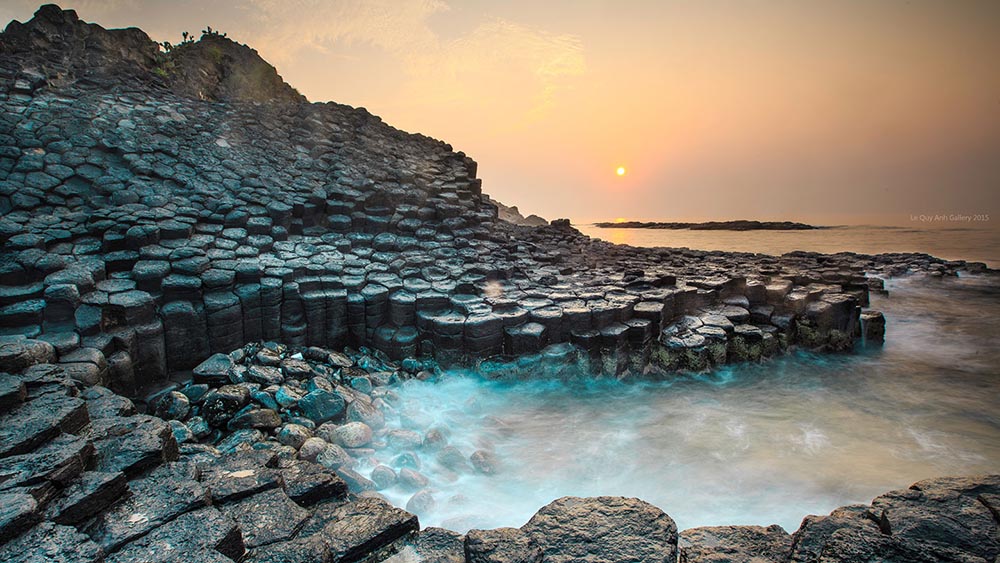
The origin of Gành Đá Đĩa can be traced back to significant volcanic activity that took place in the Vân Hòa Plateau region, where that volcanic eruption generated extensive lava flows. The cataclysmic release of magma profoundly altered the landscape, creating a foundation that would form the breathtaking geological formations characteristic of Gành Đá Đĩa today. This volcanic event occurred roughly 200 million years ago during the Mesozoic era, a time famous for its considerable geological and biological changes.
Eruption Dynamics: During the volcanic eruption, molten lava surged forth from the Earth's crust, spewing into the surrounding environment. When this lava encountered the cold ocean waters, the rapid temperature variation caused instant solidification and fragmentation, leading to the unique formation of hexagonal columns.
Long-Term Geological Wave Action: Over the years, constant waves and tides have polished the edges of the basalt columns, creating smooth surfaces that further enhance the visual allure of Gành Đá Đĩa. This continuous interaction between the sea and the solidified lava results in an ongoing transformation of the site, contributing to its geological significance.
| Volcanic Activity | Impact on Formation |
|---|---|
| Type | Eruption in the Vân Hòa Plateau |
| Era | Mesozoic, approximately 200 million years ago |
| Result | Formation of distinctive hexagonal basalt columns |
| Ongoing Interaction | Sea action continues to shape and smooth the rocks |
Understanding the volcanic history of Gành Đá Đĩa is essential to appreciating its unique geological features. The site serves as a live testament to the elemental forces of nature, showcasing not just the beauty of the formations but also the dynamics of our planet's geology.
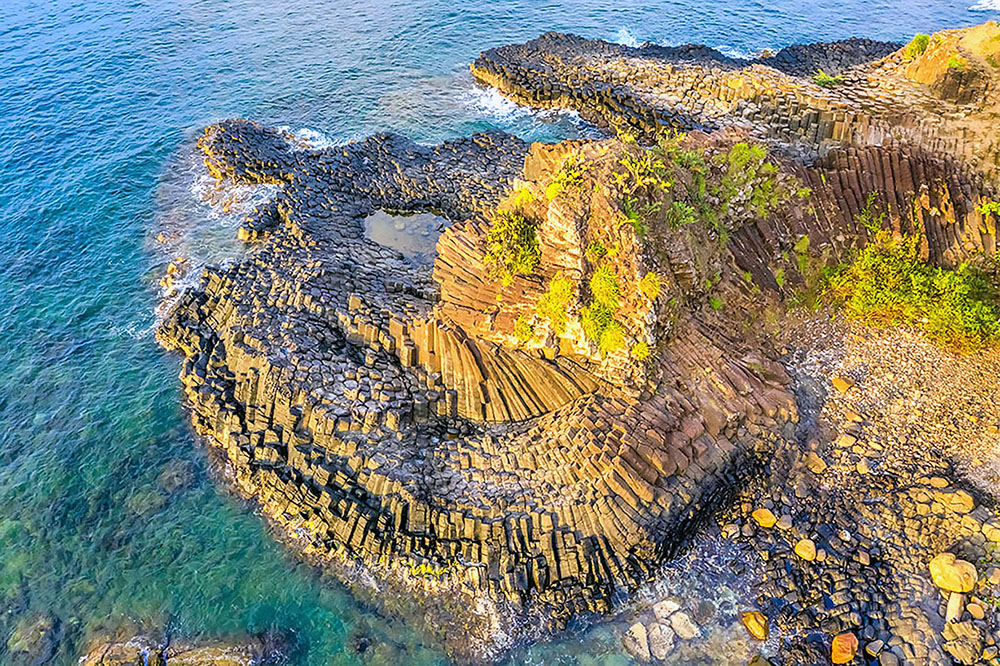
Gành Đá Đĩa is strategically located in the An Ninh Dong Commune of Tuy An District in Phu Yen Province. This picturesque site is approximately 30 kilometers away from Tuy Hòa, the capital of Phu Yen Province. Travelers can easily access this beautiful destination by following a straightforward route. The convenience of its location makes it an attractive day-trip destination for both local residents and international tourists who seek to immerse themselves in the raw beauty of Vietnam's coastal landscapes.
Accessibility to Gành Đá Đĩa is facilitated by well-paved roads and transportation options that cater to various preferences. The most common route allows visitors to enjoy scenic views along the coast as they travel towards the cliffs. Here’s a look at some of the ways to reach Gành Đá Đĩa:
Traveling to Gành Đá Đĩa from Tuy Hòa is not only about reaching the destination but also about enjoying a beautiful journey along the coast.
By Car: The quickest way is to take National Highway 1A north towards Chí Thạnh Town. After about 30 kilometers, travelers should turn right and continue for roughly 12 kilometers east until they reach the cliffs. The total travel time is generally around 45 minutes to an hour by car.
Public Transportation: For those who prefer local transport, public buses are available from Tuy Hòa to Tuy An District. From there, taxis or motorbike rentals can be utilized as the final stretch to Gành Đá Đĩa. It's advisable to confirm bus routes and schedules beforehand, as they can vary.
From Other Major Cities:
| Mode of Transportation | Description |
|---|---|
| Car | Approx. 30 km from Tuy Hòa (45 minutes to 1 hour) |
| Public Bus | Local buses to Tuy An, followed by taxis |
| Flights | Accessible via Tuy Hòa Airport from major cities |
The route to Gành Đá Đĩa enhances the experience of visiting the coastline due to its scenic beauty, with ample opportunities for photography and absorbing Vietnam's natural environment.
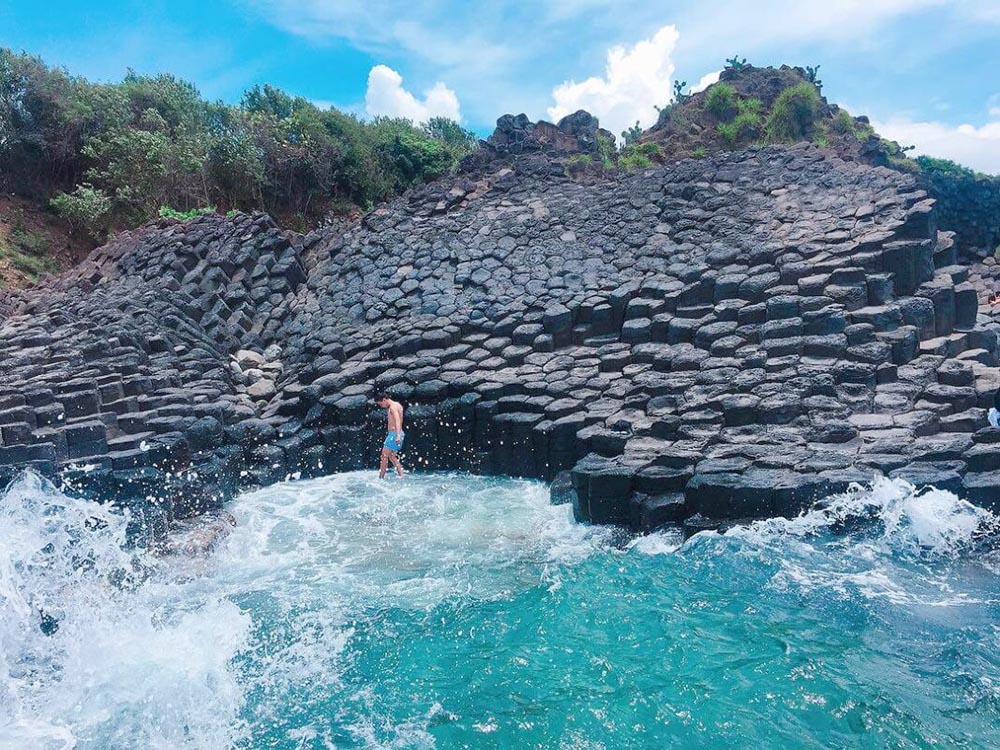
Visiting Gành Đá Đĩa can be a delightful journey regardless of whether you travel by private vehicle, public transport, or air travel. Here are detailed travel options for visitors considering a journey to this natural marvel:
Traveling from Tuy Hòa: As mentioned, taking a car or public bus is the most convenient option. Visitors can enjoy the rural scenery and local life along the route, enhancing their travel experience. There are numerous opportunities for picturesque stops before reaching the cliffs.
Traveling from Nearby Cities:
Paved Roads: The road leading to Gành Đá Đĩa is well-maintained and marked, making navigation easy for travelers. The backdrop of mountains provides a stunning context for the eventual arrival at the cliffs.
Accessibility for All: This site also welcomes family and elderly visitors, as well as those seeking a peaceful retreat amidst natural wonders.
| Distance (from) | Estimated Travel Time | Transport Options |
|---|---|---|
| Tuy Hòa City | 45-60 minutes | Car, Public Bus |
| Ho Chi Minh City | 1 hour flight + 30 mins by taxi | Flight + Car |
| Nha Trang | 3-4 hours | Bus or Car |
Gành Đá Đĩa is not just a destination; it is an experience that begins the moment you embark on your journey. The view along the way and the anticipation build excitement, making it a popular spot for tourists exploring the enchanting province of Phu Yen.
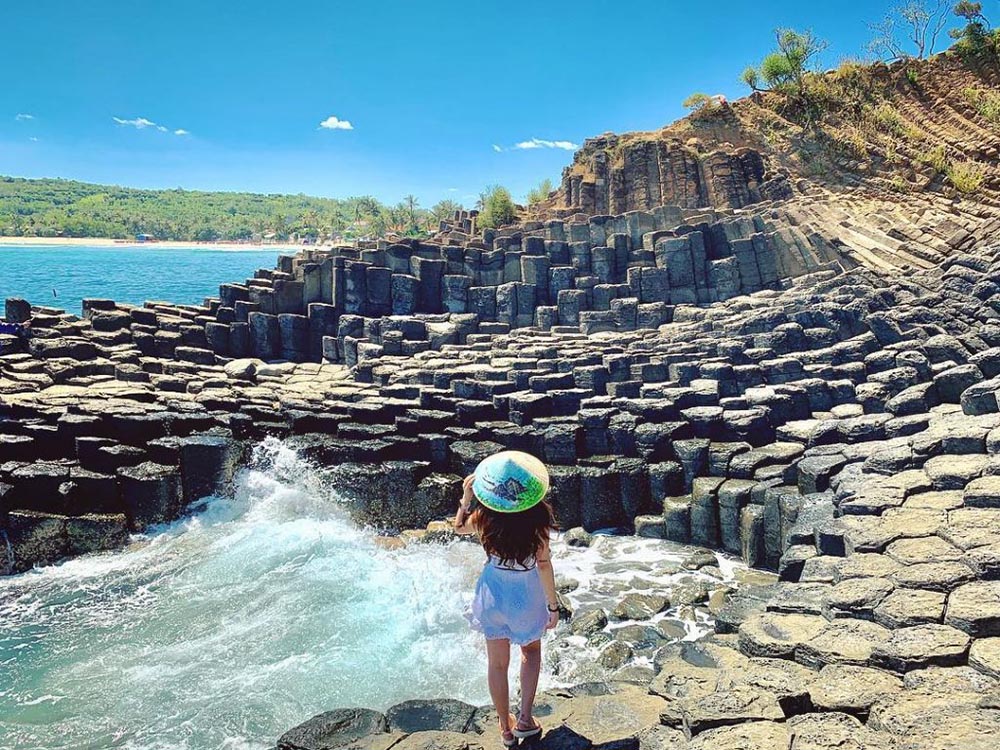
When one considers the Sea Cliff of Stone Plates, Gành Đá Đĩa, it’s impossible not to draw comparisons to similar geological sites around the world. One of the most renowned counterparts is Ireland's Giant's Causeway, a UNESCO World Heritage site that shares many similarities with Gành Đá Đĩa. Analyzing the key features of both sites reveals fascinating insights into their geological significance and tourist appeal.
Gành Đá Đĩa and the Giant's Causeway are similar in many ways; however, they each possess unique characteristics that enhance their appeal.
Geological Formation:
Geographic and Climatic Differences:
| Feature | Gành Đá Đĩa | Giant's Causeway |
|---|---|---|
| Formation Age | Approximately 200 million years ago | Approximately 60 million years ago |
| Column Count | Around 35,000 | About 40,000 |
| Climate | Tropical | Temperate Maritime |
| Accessibility | Road access from Tuy Hòa | Visitor center and guided paths |
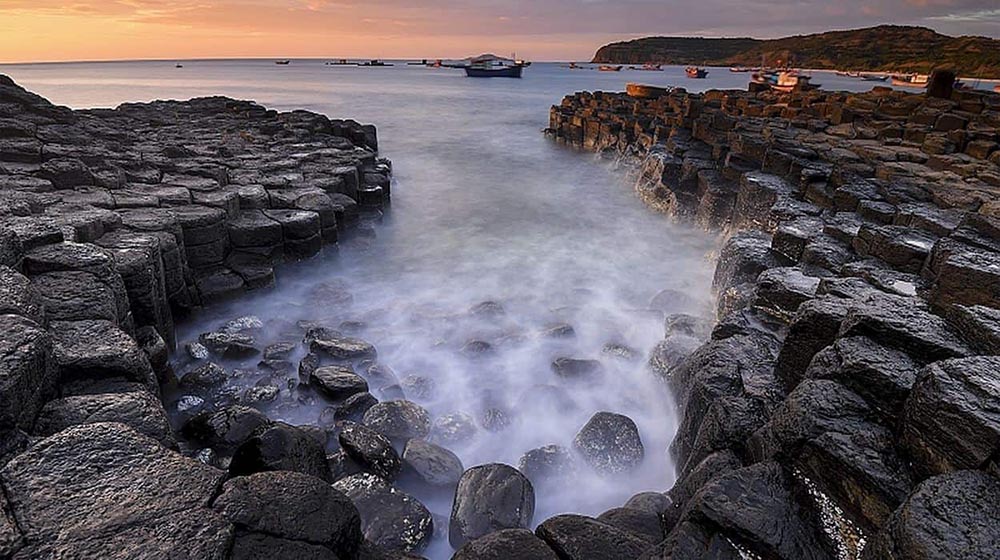
Cultural and Historical Context:
Tourism and Visitor Experience:
| Comparison Aspect | Gành Đá Đĩa | Giant's Causeway |
|---|---|---|
| Visitor Experience | Unique, less commercialized | More structured and tourist-friendly |
| Legend and Culture | Local legends enrich the site | Associated with famous folklore |
While both Gành Đá Đĩa and the Giant's Causeway are awe-inspiring natural sites with shared geological origins, each one tells a distinct story of its environment, culture, and the natural forces that shaped them. Your experience at Gành Đá Đĩa is certain to be unique, both for its environmental beauty and the lore that surrounds it.
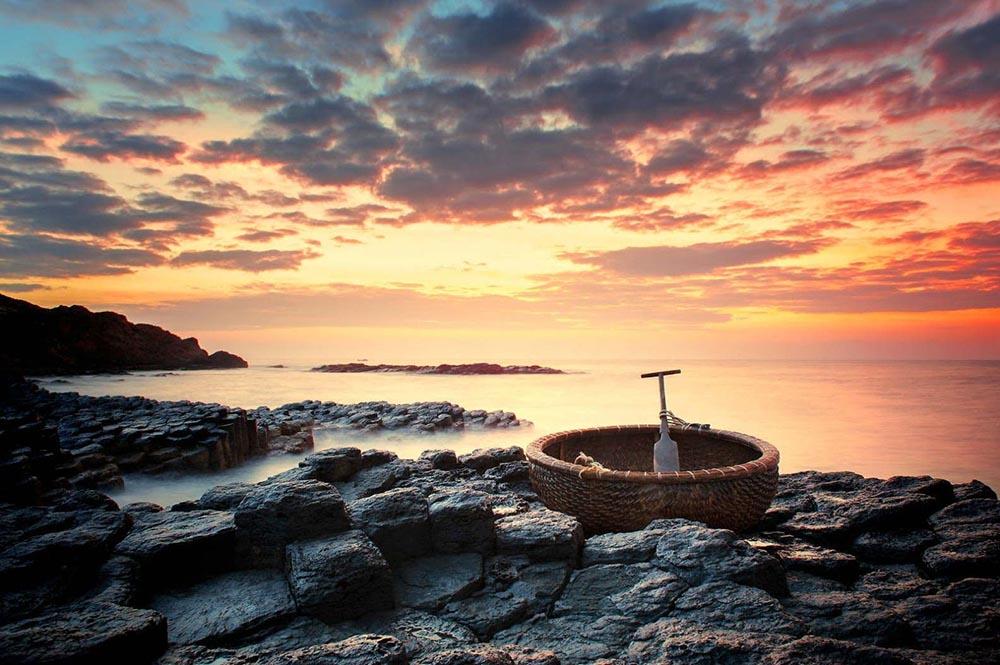
Gành Đá Đĩa stands out not only for its stunning geographical attributes but also for its unique environmental and cultural features that contribute to its charm and allure. The cliffs capture the imagination through several distinct aspects:
Basalt Column Configuration: The interlocking basalt columns at Gành Đá Đĩa distinctly differ in size and shape, with some uniquely flat surfaces creating configurations that resemble vast dinner plates or stone tables. This visually striking formation leads to countless opportunities for exploration and photography.
Natural Heritage Designation: Recognized as a National Heritage site in Vietnam, Gành Đá Đĩa enjoys protections that highlight its critical environmental and cultural value. This designation fosters preservation efforts that ensure its geological features remain intact for future generations to experience.
Ecological Significance: The cliffs serve as a valuable ecosystem, hosting an assortment of marine life and offering critical habitats for various species. The interface between land and sea around Gành Đá Đĩa allows for vital biodiversity, with opportunities to observe both terrestrial and aquatic wildlife.
| Unique Feature | Description |
|---|---|
| Column Structure | Unique interlocking basalt columns resembling stone plates |
| Heritage Designation | Recognized as a National Heritage site of Vietnam |
| Biodiversity | Host to a variety of marine and terrestrial species |
Cultural Significance: The legends and folklore surroundingGành Đá Đĩa enhance the site’s cultural richness. Locals pass down stories related to the cliffs, creating a narrative that fosters a deeper appreciation for the land and its history, making it an intriguing place for visitors.
Visual Aesthetic: The sight of Gành Đá Đĩa, particularly at sunrise or sunset, is nothing short of magical. The contrasting colors of the sea, sky, and rock formations declare an enchanting atmosphere that captures the hearts of all who witness it, making for unforgettable experiences.
| Aesthetic Aspect | Description |
|---|---|
| Sunrise/Sunset Views | Enhances visual beauty and photography opportunities |
| Contrast of Elements | Vivid colors and textures create striking landscapes |
The unique features of Gành Đá Đĩa bring a rich tapestry of geological, ecological, and cultural tales to life, further elevating its status as a must-see destination in Vietnam.
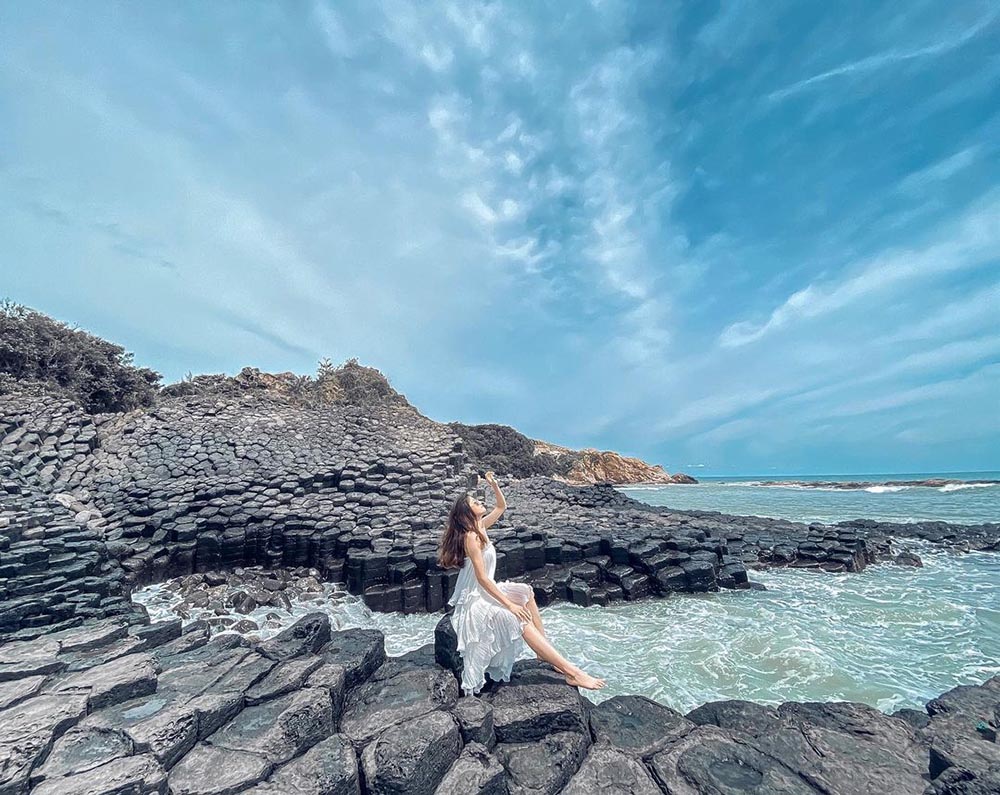
Visiting Gành Đá Đĩa is not simply about gazing at a geological wonder; it's also a holistic experience that combines exploration, cultural engagement, and sensory delight. As tourists embark on their journey to the Sea Cliff of Stone Plates, they can expect a variety of activities and features that enhance their visit.
Engaging with the natural beauty of Gành Đá Đĩa offers several opportunities for visitors to appreciate the site fully. Here are some of the activities that individuals can partake in during their visit:
Exploring Rock Formations: The primary draw to Gành Đá Đĩa is of course the unique basalt formations. Visitors can walk between the columns, marveling at the differences in texture and shape. The thrill of wandering through this remarkable landscape is an adventure in itself.
Photography Opportunities: The breathtaking views created by the interplay of light and shadow throughout the day make Gành Đá Đĩa an ideal location for photography. The cliffs appear particularly enchanting during dawn and dusk, allowing visitors to capture the magnificent beauty of the basalt formations against the ocean backdrop.
Picnicking on the Rocks: The flat surfaces of the columns lend themselves well to picnicking. Families and friends can enjoy homemade meals together while soaking in the beauty of their surroundings. It's a great way to enhance the experience with shared memories.
Listening to the Sea: The rhythmic crashing of waves against the basalt columns provides a natural soundtrack to the visit. Many visitors find joy in simply taking a moment to sit quietly, absorbing the peaceful atmosphere and connection to nature.
Nearby Attractions: Gành Đá Đĩa is also close to other interesting sites, such as Gành Đèn Lighthouse and Bai Bang beach. Visitors can seamlessly incorporate additional exploration during their trip and enjoy a full day of experiences.
| Activities | Description |
|---|---|
| Rock Exploration | Walk through and appreciate geological formations |
| Photography | Capture stunning views, especially at sunrise/sunset |
| Picnicking | Enjoy meals on the basalt columns |
| Nature Sounds | Experience the calming ocean waves |
| Nearby Attractions | Explore additional local sites |
Each activity at Gành Đá Đĩa encourages a deeper connection with the landscape, providing visitors with a meaningful experience that will linger in their memories long after they leave.
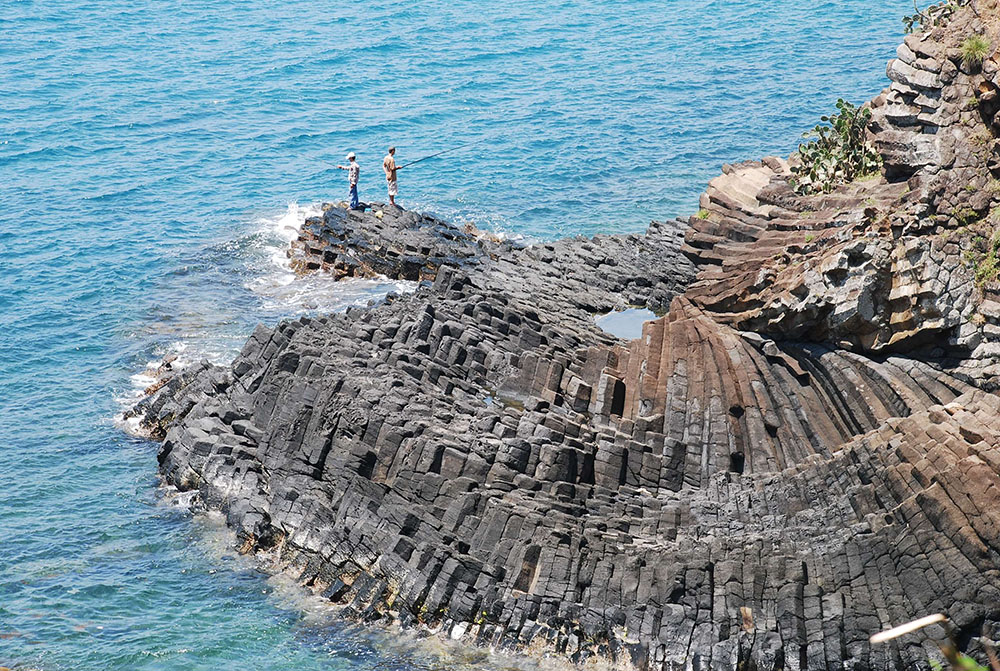
To truly enjoy an enriching experience at Gành Đá Đĩa, visitors will find a variety of accommodations and dining options in the vicinity. The surrounding areas cater to different preferences and budgets, ensuring that travelers will have everything they need to make their stay enjoyable.
Accommodations: A range of hotels and resorts can be found in nearby Tuy Hòa, offering various room options to accommodate travelers. Prices may vary significantly, as the region caters to both budget-friendly and luxury preferences:
Eateries: Local dining options are abundant, with a focus on fresh seafood and regional specialties. Local restaurants near Gành Đá Đĩa are known for their delicious offerings:
| Accommodation Type | Price Range (VND) |
|---|---|
| Budget Hotels | 150,000 - 500,000 |
| Mid-Range Hotels | 500,000 - 1,500,000 |
| Luxury Resorts | 1,500,000 and above |
Gành Đá Đĩa not only provides visitors a chance to engage with stunning natural beauty but also offers various conveniences to ensure their stay is pleasant and fulfilling. The combination of local accommodation and eateries allows travelers to immerse themselves in the culture and flavors of Phu Yen Province.
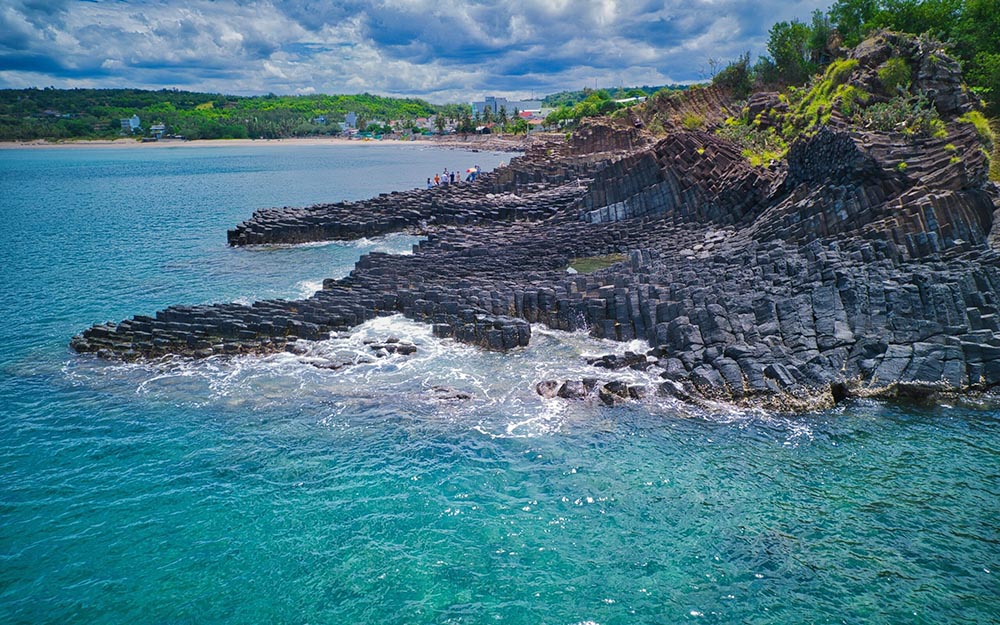
Gành Đá Đĩa is renowned not only for its stunning visual appeal but also for its geological and cultural significance. As a national heritage site, it plays an essential role in Vietnam's natural landscape and cultural narrative.
Officially designated as a National Heritage site by the Vietnamese Ministry of Culture, Sports and Tourism in January 1998, Gành Đá Đĩa holds a unique position in Vietnam's cultural and geological catalog. This recognition derives from a series of compelling reasons:
Geological Importance: The presence of approximately 35,000 interlocking basalt columns makes Gành Đá Đĩa a prime example of volcanic activity and geological processes. It serves as a valuable resource for scientists and geologists interested in the science of volcanology and the study of basalt formations.
Cultural Significance: Gành Đá Đĩa is intertwined with the history and folklore of the region. Local legends enrich the cultural narrative, contributing to the heritage of Phu Yen Province. Visitors often seek to discover the stories associated with these cliffs, connecting them not only with the geological history but also with cultural origins.
Biodiversity and Conservation: The protection of Gành Đá Đĩa ensures that the surrounding ecosystem remains preserved. The site is habitat to various marine species, making it a vital segment of the region's natural resources. The conservation efforts enhance both education and tourism, allowing visitors to appreciate the ecological importance of such environments.
| Significance Aspect | Description | |----------------------+|---------------------------------------------------| | Geological Importance | Key study site for volcanology and basalt formations| | Cultural Significance | Rich local legends and history enhance its narrative| | Biodiversity | Habitat for numerous marine and terrestrial species |
Gành Đá Đĩa proudly embodies Vietnam's commitment to preserving its natural and cultural heritage while providing an accessible yet profound experience for those who come to admire its beauty.
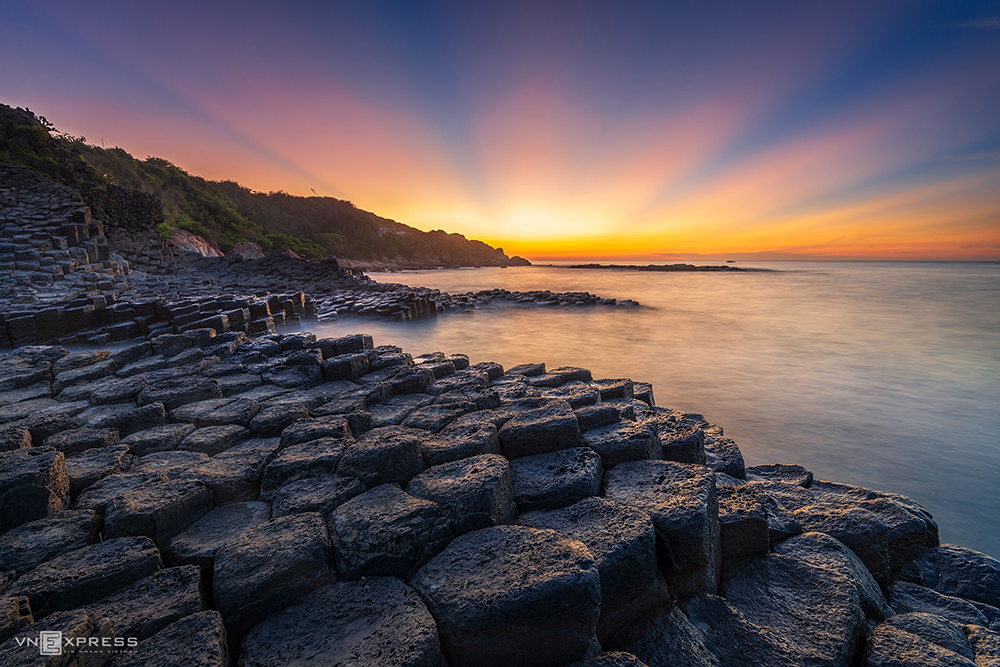
The importance of Gành Đá Đĩa extends beyond mere aesthetics, as it serves as a crucial point of interest for both geologists and tourists.
Geological Importance: The site allows geologists to study the processes behind volcanic activity and basalt column formation. Understanding the physical occurrences that shaped Gành Đá Đĩa enriches scientific knowledge, contributing to the broader understanding of Earth's geological history.
Tourist Appeal: For tourists, Gành Đá Đĩa is a captivating destination providing a blend of scenic beauty, recreational activities, and cultural engagement. Visitors often leave with cherished memories, photos, and stories that enhance their perception of Vietnam’s rich natural and cultural history.
Community Engagement: The site additionally fosters community involvement, as locals support conservation efforts and promote cultural tourism. This engagement allows the area to flourish economically while preserving its ecological integrity.
| Purpose | Importance |
|---|---|
| For Geologists | Study of volcanic processes and geological features |
| For Tourists | Blend of beauty, culture, and recreation |
| Community Engagement | Promotes conservation and economic growth |
In summary, Gành Đá Đĩa plays a vital role in both geological research and tourism, serving as a conduit for learning and appreciation of Vietnam's extraordinary natural landscapes.
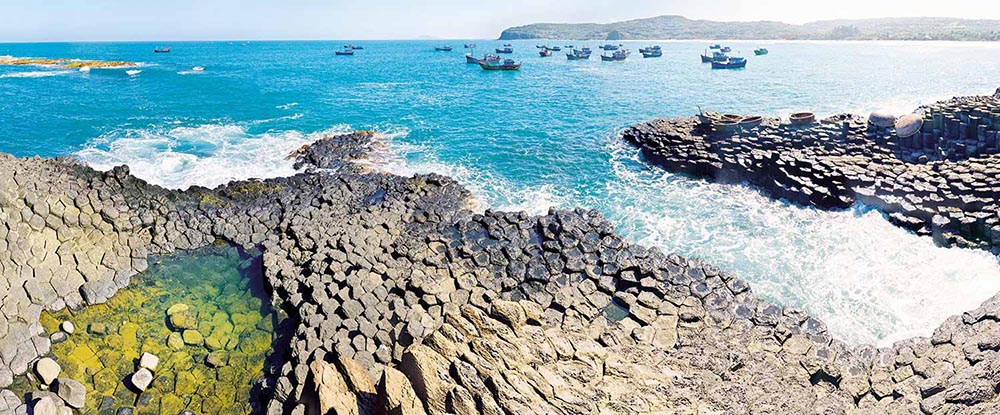
What is Gành Đá Đĩa?
How do I get to Gành Đá Đĩa?
What activities can I do at Gành Đá Đĩa?
Are there dining options near Gành Đá Đĩa?
Is Gành Đá Đĩa a protected site?
What is the best time to visit Gành Đá Đĩa?
In conclusion, Gành Đá Đĩa, or the Sea Cliff of Stone Plates, stands as a magnificent natural testament to the geological history of Vietnam. The captivating formations not only mesmerize visitors with their beauty but also enrich our understanding of volcanic processes and history. As a National Heritage site, Gành Đá Đĩa fosters appreciation for both the natural environment and the local culture, drawing in tourists from around the globe. The blend of recreational activities, exploration, and cultural lore makes Gành Đá Đĩa a must-visit destination for anyone looking to experience the stunning landscapes of Phu Yen Province. Whether you are a geology enthusiast, a nature lover, or someone who seeks to unveil the stories of ancient lands, the memories created at Gành Đá Đĩa are sure to last a lifetime.